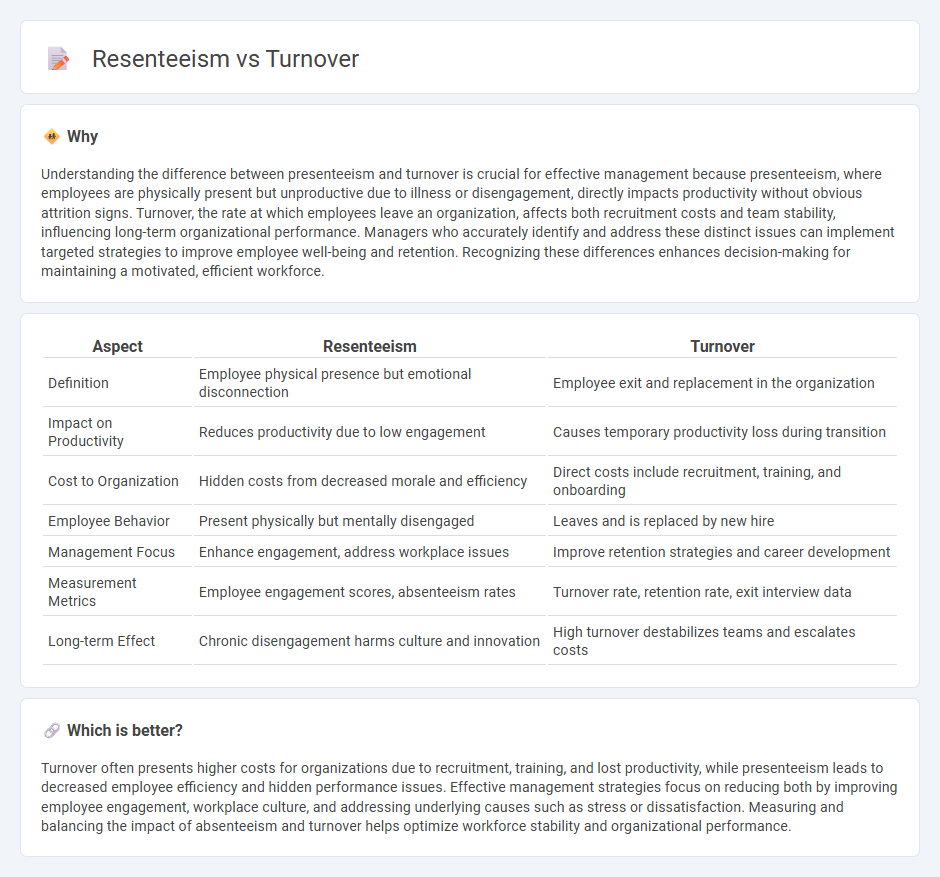
Resenteeism refers to employees physically attending work while mentally disengaged or unproductive, contrasting with turnover, which denotes employees leaving an organization altogether. Both metrics significantly impact operational efficiency and labor costs, with resenteeism eroding productivity and turnover driving recruitment expenses. Explore how managing these factors effectively can enhance workplace performance and retention.
Why it is important
Understanding the difference between presenteeism and turnover is crucial for effective management because presenteeism, where employees are physically present but unproductive due to illness or disengagement, directly impacts productivity without obvious attrition signs. Turnover, the rate at which employees leave an organization, affects both recruitment costs and team stability, influencing long-term organizational performance. Managers who accurately identify and address these distinct issues can implement targeted strategies to improve employee well-being and retention. Recognizing these differences enhances decision-making for maintaining a motivated, efficient workforce.
Comparison Table
| Aspect | Resenteeism | Turnover |
|---|---|---|
| Definition | Employee physical presence but emotional disconnection | Employee exit and replacement in the organization |
| Impact on Productivity | Reduces productivity due to low engagement | Causes temporary productivity loss during transition |
| Cost to Organization | Hidden costs from decreased morale and efficiency | Direct costs include recruitment, training, and onboarding |
| Employee Behavior | Present physically but mentally disengaged | Leaves and is replaced by new hire |
| Management Focus | Enhance engagement, address workplace issues | Improve retention strategies and career development |
| Measurement Metrics | Employee engagement scores, absenteeism rates | Turnover rate, retention rate, exit interview data |
| Long-term Effect | Chronic disengagement harms culture and innovation | High turnover destabilizes teams and escalates costs |
Which is better?
Turnover often presents higher costs for organizations due to recruitment, training, and lost productivity, while presenteeism leads to decreased employee efficiency and hidden performance issues. Effective management strategies focus on reducing both by improving employee engagement, workplace culture, and addressing underlying causes such as stress or dissatisfaction. Measuring and balancing the impact of absenteeism and turnover helps optimize workforce stability and organizational performance.
Connection
Resenteeism and turnover are interconnected as high levels of employee burnout and dissatisfaction often lead to increased absenteeism and ultimately higher turnover rates in management. When employees frequently resent workplace conditions or leadership, they are more likely to disengage, leading to reduced productivity and a greater likelihood of leaving the organization. Effective management strategies that address employee concerns and foster a positive work environment can mitigate resilience issues and lower both absenteeism and turnover rates.
Key Terms
Employee Engagement
High employee turnover and absenteeism significantly impact organizational productivity and morale, with low engagement often cited as a primary cause. Studies show companies with engaged employees experience 41% lower absenteeism rates and 59% lower turnover rates, emphasizing the critical role of employee satisfaction in retention. Discover effective strategies to boost engagement and reduce costly turnover and absenteeism in your workforce.
Retention Strategies
High turnover rates directly increase recruitment costs and disrupt organizational productivity, while absenteeism leads to lost workdays and decreased employee morale. Effective retention strategies such as employee engagement programs, competitive compensation, and flexible work arrangements significantly reduce both turnover and absenteeism rates. Explore innovative retention solutions to enhance workforce stability and boost overall business performance.
Organizational Culture
Organizational culture significantly influences both turnover and absenteeism rates by shaping employee engagement, job satisfaction, and workplace morale. Companies with strong, positive cultures experience reduced turnover and lower absenteeism, as employees feel valued and motivated to contribute. Explore strategies to enhance your organizational culture and improve workforce stability.
Source and External Links
Reduce Employee Turnover with BambooHR Insights - Employee turnover measures how many employees leave an organization during a specific period and is categorized as voluntary (when employees choose to leave) or involuntary (when the employer terminates employment).
Turnover (band) - Turnover is an American rock band known for evolving from emo and pop-punk roots to an indie dream-pop sound, with notable albums including Peripheral Vision and Good Nature.
Turnover - In sports, turnover refers to the loss of possession of the ball to the opposing team, as seen in basketball, football, and rugby.
 dowidth.com
dowidth.com